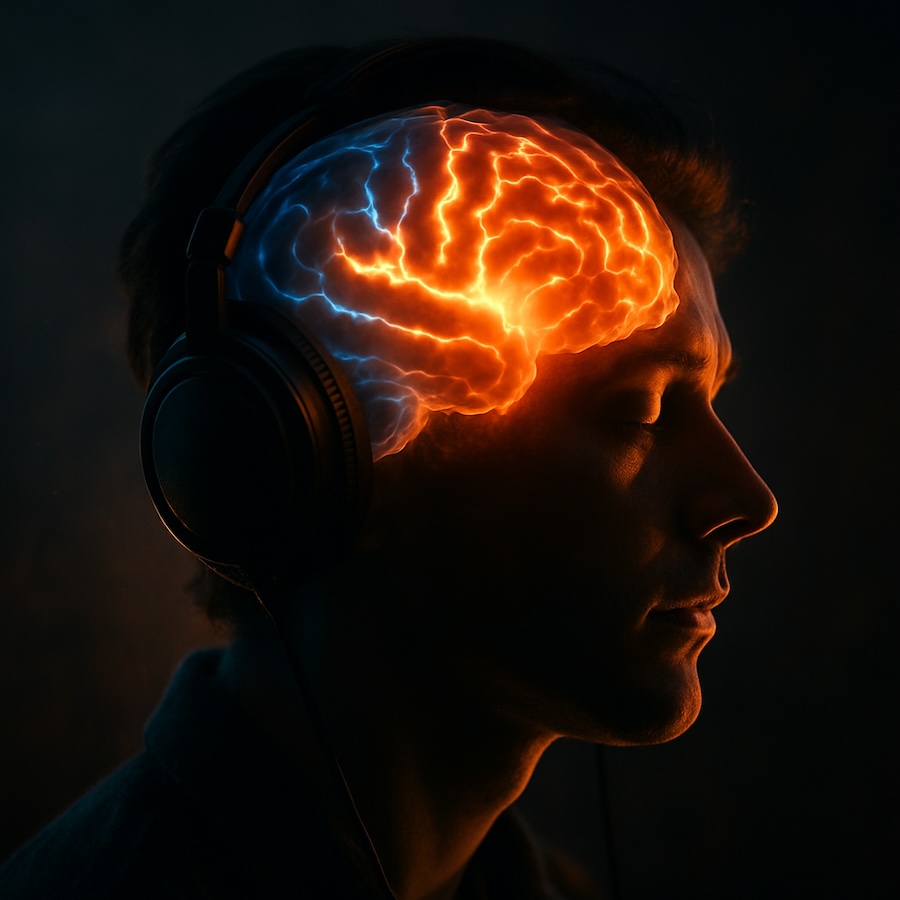The Brain Lights Up When Listening to Music: Discover How Music Transforms Your Mind

Different areas of the brain are activated when we listen to music, creating unique patterns of neural activity.
Your heart beats faster, your palms sweat, and a part of your brain called Heschl’s gyrus lights up like a Christmas tree. This is what happens when you listen to music. But have you ever wondered why something as abstract as music can trigger such consistent reactions in your brain and body?
Scientists at the University of Southern California have been investigating exactly this phenomenon, using artificial intelligence to analyze how music affects the brain, body, and emotions of listeners. Their findings reveal fascinating insights into the neurological processes that make us love music.
“Having a holistic view of musical perception, using different types of musical predictors, gives us an unprecedented view of how our bodies and brains respond to music.” — Tim Greer, Lead Researcher
In this article, we’ll explore how your brain lights up when listening to music, the scientific evidence behind music’s effects on your mind, and how you can use this knowledge to enhance your well-being.
Quick Navigation
What Happens in Your Brain When Listening to Music
When you listen to music, your brain engages in a complex neural dance. The research team from USC analyzed heart rate, skin galvanic response (sweat gland activity), brain activity, and subjective feelings of happiness and sadness in volunteers while they listened to three different unfamiliar pieces of music.
Out of 74 musical characteristics examined, researchers found that dynamics, register, rhythm, and harmony were particularly useful in predicting listeners’ responses. The study revealed that music activates multiple brain regions simultaneously, creating a neural symphony of its own.
According to neuroscience research, when you listen to music:
- Your auditory cortex processes the sound
- Your motor cortex responds to the rhythm
- Your limbic system generates emotional responses
- Your corpus callosum connects both brain hemispheres
- Your prefrontal cortex evaluates and anticipates musical patterns
This multi-region activation explains why music can influence so many aspects of our experience, from mood and memory to physical movement and cognitive performance.
Heschl’s Gyrus: Your Brain’s Music Center
Among their findings, researchers noticed that music powerfully influenced specific brain parts in the auditory complex named Heschl’s gyrus and the superior temporal gyrus. These regions are crucial for processing sound and are particularly responsive to music.
Heschl’s gyrus responds strongly to the clarity of pulse or beat strength. In simple terms, your Heschl’s gyrus becomes very active when you hear songs with a strong, clear beat (think of Lady Gaga’s “Bad Romance” or any song with a prominent rhythm).
This biological response helps explain why rhythm is so fundamental to our experience of music across all cultures and why humans have an intrinsic ability to synchronize their movements to musical beats.
Interestingly, musicians typically have larger Heschl’s gyri than non-musicians, suggesting that musical training physically changes this part of the brain, enhancing auditory processing capabilities.
Why Musical Contrast Is Crucial
The researchers discovered that changing dynamics, rhythm, and timbre, or the introduction of new instruments, causes a significant spike in neural activity. In other words, contrast is crucial to how our brains process and enjoy music.
For example, the gyri become particularly activated when there’s a change in dynamics or volume. This explains why many songs follow a pattern of quiet verses followed louder choruses – this structure creates contrast that our brains find stimulating.
“A composer’s job is to take you on an emotional rollercoaster in under three minutes, and dynamic variability is one of the ways to accomplish this.”
The team also found that the galvanic skin response (essentially, a measure of sweating) increased after the introduction of a new instrument or the beginning of a musical crescendo. As Tim Greer, the lead researcher noted: “When each new instrument enters, you can see a spike in the collective skin response.”
Additionally, the most stimulating musical moments were preceded an increase in the complexity level of the song. Essentially, the more instruments in the song, the more people reacted. This principle is brilliantly demonstrated in pieces like Mike Oldfield’s “Tubular Bells,” where the song develops a crescendo rhythm while gradually adding more instruments.
The Research Methods
For their experiment, the team selected three emotional musical pieces that didn’t contain lyrics and weren’t very familiar to avoid adding any memory elements to the listeners’ responses. (Hearing a song that played in the background during a dental extraction, for example, could skew perception.)
In the experiment:
- 40 volunteers listened to musical extracts, both sad and happy, while their brains were scanned using magnetic resonance imaging at USC’s Brain and Creativity Institute.
- 60 people listened to music on headphones while their cardiac activity and skin conductance were monitored.
- The same group also rated the intensity of emotions (happy or sad) from 1 to 10 while listening to the music.
Then, computer scientists analyzed the data using artificial intelligence algorithms to determine which auditory characteristics consistently evoked responses in people.
What makes this study groundbreaking is its multimodal approach. In the past, neuroscientists trying to better understand music’s impact on the body, brain, and emotions had analyzed magnetic resonance brain scans in short segments of time, such as observing the brain reacting to two seconds of music. In contrast, this study used algorithms to analyze the data collected in the lab, allowing scientists to observe how people felt listening to music over longer periods, not just through brain scans but combining data in various ways.
Neurological Benefits of Music
Enhanced Cognitive Performance
Regular music listening has been shown to improve cognitive functions, including memory, attention, and problem-solving skills. The complex patterns in music exercise neural pathways similar to those used in spatial-temporal reasoning.
Stress Reduction
Music can significantly lower cortisol levels, reducing physiological stress responses. Slow, relaxing music particularly affects the parasympathetic nervous system, promoting relaxation and lowering blood pressure and heart rate.
Mood Enhancement
Music triggers the release of dopamine, the “feel-good” neurotransmitter, creating a natural high. This makes music a powerful tool for mood regulation and emotional well-being, with effects that can last well beyond the listening experience.
Pain Management
Music activates the brain’s opioid system, which can reduce pain perception. Studies have shown that patients who listen to music before, during, or after surgery experience less pain and require fewer pain medications.
Music as a Therapeutic Tool
Beyond helping researchers identify songs for the perfect workout, study, or sleep playlist, the investigation has important therapeutic applications. Music has been proven to calm anxiety, relieve pain, and help people with disabilities and dementia.
“From a therapy perspective, music is a really great tool to induce emotion and improve mood,” said Assal Habibi, research co-author.
Using this research, therapists can design musical stimuli for treating depression and other mood disorders. It also helps us understand how emotions are processed in the brain.
Music therapy has shown promising results in treating:
- Post-traumatic stress disorder (PTSD)
- Anxiety disorders
- Depression
- Parkinson’s disease
- Alzheimer’s and dementia
- Stroke recovery
- Autism spectrum disorders
The field of neurologic music therapy (NMT) continues to grow as researchers discover more about how music affects specific neural pathways and can be used to target particular brain functions.
Practical Applications: Using Music for Your Brain Health
Based on neuroscientific research, here are some ways you can use music to benefit your brain:
For Focus & Productivity
Choose instrumental music with consistent rhythms and moderate tempos. Classical music, especially baroque, or ambient electronic music can enhance concentration providing stimulation without being distracting.
For Sleep & Relaxation
Music with 60-80 beats per minute (which matches a resting heart rate) can help induce sleep. Look for pieces with gentle dynamics, minimal contrast, and soothing timbres like piano or string instruments.
For Exercise & Motivation
Music with strong beats and energetic dynamics can improve workout performance. Pieces with tempos between 120-140 BPM align well with most exercise activities and can help maintain pace and motivation.
For Memory & Learning
The “Mozart Effect” suggests that complex classical music may temporarily enhance spatial-temporal reasoning. Consider listening to complex musical pieces before engaging in tasks requiring these skills.
According to researchers, future studies could analyze how different types of music can positively manipulate our emotional responses, and whether the composer’s intent matches the listener’s perception of a musical piece.
Conclusion: Your Brain on Music
The relationship between music and the brain remains one of the most fascinating areas of neuroscience research. As we’ve seen, music isn’t just passive entertainment—it’s an active force that physically changes our brains and bodies.
From the lighting up of Heschl’s gyrus to the release of dopamine and the complex processing of musical contrasts, our brains are exquisitely tuned to respond to music in profound ways. This understanding opens doors not just for entertainment, but for therapeutic interventions and cognitive enhancement.
The next time you put on your favorite song and feel that inexplicable rush of emotion, remember that your brain is engaging in an intricate neurological dance—one that humans have been performing for thousands of years across every culture on Earth.
By understanding how music affects your brain, you can more intentionally harness its power to enhance your mood, improve your cognitive performance, and potentially even support your long-term neurological health.
Related Articles
How Learning to Play an Instrument Rewires Your Brain
Discover the cognitive benefits of musical training and how it creates lasting changes in brain structure.
Read more →The Science of Musical Preferences: Why We Like What We Like
Explore the psychological and neurological factors that shape our musical tastes and preferences.
Read more →Music for Memory: How Melodies Help Us Remember
Learn how music enhances memory formation and recall, and how it’s being used to help people with memory disorders.
Read more →



